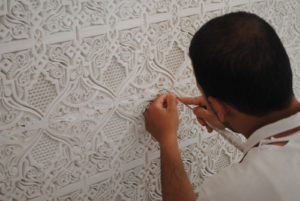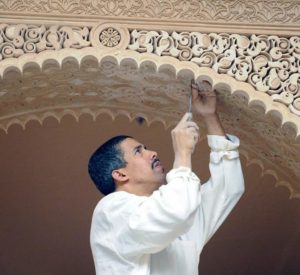Masterpiece Plaster Designs – The Moroccan Gebs
The plaster is one object of interest to Moroccan artisans – the Maalem, and they by magnifying, sculpting, chiseling, or staging the plaster, it is transformed into an exciting work of art – the gebs. The gebs can be used as covers for the upper part of walls, or above the zelliges. Likewise, these masterpieces come handy when decorating arcades or ceilings – for instance, as used in the exceptional dome at the Royal Palace of Dar Es Salaam situated in Rabat.

The Moroccan Gebs
There are large scale uses of gebs too, especially in large architectural surfaces with varying patterns, including rosettes, geometric tracery, concentric friezes, calligraphy, and Muqarnas. The gebs come in whitish light pink color, and although they can be stained in large quantities, color enhancements, gliding, and illuminations are additional ways of highlighting their beauty.
Gebs have been in use for a while, but the advent of the imported Hispano-Moorish art, which is of Mesopotamia origin initially, took the technique of making and using gebs into the next level. Thus, from the 13th century, the gebs became more prominent in interior and exterior home decor in Morocco. With ornamentation as the main aim, the plaster is spread and smoothed to form a layer of three or four centimeters in thickness on the desired surfaces. These layers are held with nails, and while it dries slowly, master craftsmen start carving.

Plaster work
The first step is usually the drawing of the preferred patterns by the Maalem, with a dry point using a compass, a ruler, stencils, and templates. After this, the master craftsmen use small chisels, thin scissors, and gouges of varying sections to cut and sculpt the fresh plaster carefully. They ensure that the cutting follows the already-sketched outline while digging deeper into some areas to highlight the shadows that will improve the relief. With time, the smooth mass of the plaster is transformed into lace, and the gebs is created. This unique art of producing gebs is associated only with the expert Moroccan master craftsmen and is popular worldwide. Thus, most countries of the world always seek ways of transitioning this invaluable ancestral art into their lands.
As far as gebs are concerned, we can say that the Chemmassiat is a continuation of this technique. However, the sculpture eventually make a complete pierce into the plasterboard, making a fine embroidery that allows the passage of sunlight. “Chems” in Arabic means “light,” hence the name – Chemmassiat. The openings formed by these piercings are eventually closed by using several small tiles of varying bright colors. These tiles are explicitly designed to filter the light, without taking away the interior coolness of the sculpture. Today, there are several Chemmasiat arts around, including the mosque of the Mohammed V Mausolem situated in Rabat.
(With regards to the Islamic architecture, gebs are considered as elements in the form of stalactites or corbels, and may be used as traditional elements between the upper part of a square room and the dome on which the room is mounted).
Working Hours
TOURS AVAILABLE
M-S: 9am - 9pm
Phone Number
CALL US IN
+212 6 66 31 90 38
© Copyright 2018 marrakechguidetours.com
“To Travel is to Live” – Hans Christian Andersen

